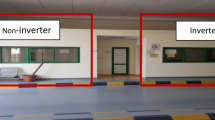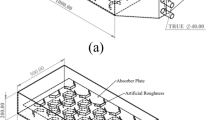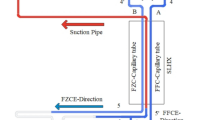Abstract
In this study, a new design for energy recovery from the return air has been introduced to improve the air handling unit (AHU) performance through the energetic analysis. The main objective is defined as the reduction in cooling and heating coils energy demand. In the novel AHU, the coldness from the exhaust air is transferred to the fresh air through the primary heat exchanger to reduce the cooling coil energy usage, while in the secondary heat exchanger, the warmness from the return air is recovered to the outlet cold air of the cooling coil to reduce the heating coil energy usage. Results showed that using air-to-air heat exchanger in hot and dry climate regions, the total energy consumption decreased up to 26.38%, which in turn increased the first law efficiency up to 35.84%, while in hot and humid climate these figures are 13.11% and 10.57%, respectively. It is concluded that the effect of using the air-to-air heat exchangers in hot and dry climate has priority over the hot and humid one.









Similar content being viewed by others
Abbreviations
- A:
-
Area \(\left( {{\text{m}}^{2} } \right)\)
- \(c\) :
-
Specific heat \(\left( {{\text{J}}\;{\text{kg}}^{ - 1} \,{\text{K}}^{ - 1} } \right)\)
- \(C\) :
-
Heat capacity rate \(\left[ {C = \dot{m}c} \right]\)\(\left( {{\text{W\,K}}^{ - 1} } \right)\)
- \(C^{*}\) :
-
Capacitance rate ratio
- \(C_{\text{s}}\) :
-
Effective specific heat \(\left( {{\text{J}}\;{\text{kg}}^{ - 1} \,{\text{K}}^{ - 1} } \right)\)
- \(\dot{E}\) :
-
Power \(\left( {\text{W}} \right)\)
- FER:
-
First efficiency ratio
- h :
-
Enthalpy \(\left( {{\text{J}}\;{\text{kg}}^{ - 1} } \right)\)
- \(h_{\text{s}}\) :
-
Supply air enthalpy
- \(\dot{m}\) :
-
Mass flow rate \(\left( {{\text{kg}}\,{\text{s}}^{ - 1} } \right)\)
- \(\dot{m}_{\text{s}}\) :
-
Supply air mass flow rate \(\left( {{\text{kg}}\,{\text{s}}^{ - 1} } \right)\)
- \(\dot{m}_{\text{f}}\) :
-
Fresh air mass flow rate \(\left( {{\text{kg}}\,{\text{s}}^{ - 1} } \right)\)
- \(\dot{m}_{\text{r}}\) :
-
Return air mass flow rate \(\left( {{\text{kg}}\,{\text{s}}^{ - 1} } \right)\)
- \(\dot{m}_{\text{c}}\) :
-
Cold water mass flow rate \(\left( {{\text{kg}}\,{\text{s}}^{ - 1} } \right)\)
- PENR:
-
Percent of energy recovery
- Q :
-
Power (W)
- \(Q_{\text{S}}\) :
-
Sensible heat transfer rate
- \(\vartheta\) :
-
Specific volume \(\left( {{\text{m}}^{ 3} \,{\text{kg}}^{ - 1} } \right)\)
- RPR:
-
Required power ratio
- T :
-
Temperature (K)
- \(T_{\text{c}}\) :
-
Cooling water temperature (K)
- \(T_{\text{o}}\) :
-
Ambient temperature (K)
- \(T_{\text{s}}\) :
-
Supply air temperature (K)
- \(\varphi\) :
-
Relative humidity
- \(\omega\) :
-
Humidity ratio \(\left( {{\text{kg}}_{\text{v}} \;{\text{kg}}_{\text{a}}^{ - 1} } \right)\)
- \(\varepsilon\) :
-
Effectiveness
- cc:
-
Cooling coil
- ci:
-
Chilled water inlet
- co:
-
Chilled water outlet
- cond:
-
Condensation
- cw:
-
Chilled water
- dew:
-
Dew point
- f:
-
Fluid
- h:
-
Heating coil
- hi:
-
Hot water inlet
- ho:
-
Hot water outlet
- hw:
-
Hot water
- max:
-
Maximum
- min:
-
Minimum
- mix:
-
Mixing box
- o:
-
Ambient
- pr:
-
Primary heat exchanger
- r:
-
Conditioned space
- se:
-
Secondary heat exchanger
- sat:
-
Saturation
- t:
-
Total
- v:
-
Vapor
- w:
-
Water
References
Liu Z, Li W, Chen Y, Luo Y, Zhang L. Review of energy conservation technologies for fresh air supply in zero energy buildings. Appl Therm Eng. 2019;148:544–56.
Zhang Y, Liu Z, Wu Z, Zhang L, Luo Y. Numerical evaluation on energy saving potential of the photovoltaic fresh air preheating system in different climate regions of China. Appl Therm Eng. 2019;154:407–18.
Shea RP, Kissock K, Selvacanabady A. Reducing university air handling unit energy usage through controls-based energy efficiency measures. Energy Build. 2019;194:105–12.
Zeng C, Liu S, Shukla A. A review on the air-to-air heat and mass exchanger technologies for building applications. Renew Sustain Energy Rev. 2017;75:753–74.
Yari M, Kalbasi R, Talebizadehsardari P. Energetic-exergetic analysis of an air handling unit to reduce energy consumption by a novel creative idea. Int J Numer Methods Heat Fluid Flow. 2019;29:3959–75.
Yang L, Huang J-n, Ji W, Mao M. Investigations of a new combined application of nanofluids in heat recovery and air purification. Powder Technol. 2019. https://doi.org/10.1016/j.powtec.2019.10.053.
Amiri HA, Shafaghat R, Alamian R, Taheri SM, Shadloo MS. Study of horizontal axis tidal turbine performance and investigation on the optimum fixed pitch angle using CFD. Int J Numer Methods Heat Fluid Flow. 2019. https://doi.org/10.1108/HFF-05-2019-0447.
Hopp-Hirschler M, Shadloo MS, Nieken U. Viscous fingering phenomena in the early stage of polymer membrane formation. J Fluid Mech. 2019;864:97–140.
Nguyen MQ, Shadloo MS, Hadjadj A, Lebon B, Peixinho J. Perturbation threshold and hysteresis associated with the transition to turbulence in sudden expansion pipe flow. Int J Heat Fluid Flow. 2019;76:187–96.
Piquet A, Zebiri B, Hadjadj A, Safdari Shadloo M. A parallel high-order compressible flows solver with domain decomposition method in the generalized curvilinear coordinates system. Int J Numer Methods for Heat Fluid Flow. 2019. https://doi.org/10.1108/HFF-01-2019-0048.
Safdari Shadloo M. Numerical simulation of compressible flows by lattice Boltzmann method. Numer Heat Transfer Part A Appl. 2019;75(3):167–82.
Shenoy DV, Shadloo MS, Peixinho J, Hadjadj A. Direct numerical simulations of laminar and transitional flows in diverging pipes. Int J Numer Methods Heat Fluid Flow. 2019. https://doi.org/10.1108/HFF-02-2019-0111.
Kalbasi R, Afrand M, Alsarraf J, Tran M-D. Studies on optimum fins number in PCM-based heat sinks. Energy. 2019;171:1088–99.
Yang L, Du K. A comprehensive review on the natural, forced, and mixed convection of non-Newtonian fluids (nanofluids) inside different cavities. J Therm Anal Calorim. 2019. https://doi.org/10.1007/s10973-019-08987-y.
Yang L, Huang J-n, Mao M, Ji W. Numerical assessment of Ag-water nano-fluid flow in two new microchannel heatsinks: Thermal performance and thermodynamic considerations. International Communications in Heat and Mass Transfer. 2020;110:104415. https://doi.org/10.1016/j.icheatmasstransfer.2019.104415.
Nadooshan AA, Kalbasi R, Afrand M. Perforated fins effect on the heat transfer rate from a circular tube by using wind tunnel: an experimental view. Heat Mass Transfer. 2018;54(10):3047–57.
Salimpour MR, Kalbasi R, Lorenzini G. Constructal multi-scale structure of PCM-based heat sinks. Continuum Mech Thermodyn. 2017;29(2):477–91.
Yang L, Du K, Zhang Z. Heat transfer and flow optimization of a novel sinusoidal minitube filled with non-Newtonian SiC/EG-water nanofluids. Int J Mech Sci. 2019;2019:105310.
Yang L, et al. An updated review on the influential parameters on thermal conductivity of nano-fluids. J Mol Liq. 2019;2019:111780.
Yang L, et al. Thermal conductivity enhancement of water by adding graphene nano-sheets: consideration of particle loading and temperature effects. Int Commun Heat Mass Transfer. 2019;109:104353.
Shanazari E, Kalbasi R. Improving performance of an inverted absorber multi-effect solar still by applying exergy analysis. Appl Therm Eng. 2018;143:1–10.
Zhang L, Zha X, Song X, Zhang X. Optimization analysis of a hybrid fresh air handling system based on evaporative cooling and condensation dehumidification. Energy Convers Manag. 2019;180:83–93.
Eades WG. Energy and water recovery using air-handling unit condensate from laboratory HVAC systems. Sustain Cities Soc. 2018;42:162–75.
Lyu W, Li X, Wang B, Shi W. Energy saving potential of fresh air pre-handling system using shallow geothermal energy. Energy Build. 2019;185:39–48.
Lee JM, Hong SH, Seo BM, Lee KH. Application of artificial neural networks for optimized AHU discharge air temperature set-point and minimized cooling energy in conventional VAV system. Appl Therm Eng. 2019;153:726.
Afram A, Janabi-Sharifi F, Fung AS, Raahemifar K. Artificial neural network (ANN) based model predictive control (MPC) and optimization of HVAC systems: a state of the art review and case study of a residential HVAC system. Energy Build. 2017;141:96–113.
Chen Y, Treado S. Development of a simulation platform based on dynamic models for HVAC control analysis. Energy Build. 2014;68:376–86.
He X, Zhang Z, Kusiak A. Performance optimization of HVAC systems with computational intelligence algorithms. Energy Build. 2014;81:371–80.
Homod RZ. Assessment regarding energy saving and decoupling for different AHU (air handling unit) and control strategies in the hot-humid climatic region of Iraq. Energy. 2014;74:762–74.
Yun GY, Choi J, Kim JT. Energy performance of direct expansion air handling unit in office buildings. Energy Build. 2014;77:425–31.
Kusiak A, Xu G. Modeling and optimization of HVAC systems using a dynamic neural network. Energy. 2012;42(1):241–50.
Kusiak A, Zeng Y, Xu G. Minimizing energy consumption of an air handling unit with a computational intelligence approach. Energy Build. 2013;60:355–63.
CIBSE, CIBSE Guide B. Heating, ventilating, air conditioning and refrigeration. Chartered Institution of Building Services Engineers, London. 2004.
Yang L, Mao M, Huang J-n, Ji W. Enhancing the thermal conductivity of SAE 50 engine oil by adding zinc oxide nano-powder: An experimental study. Powder Technol 2019;356:335–41.
Yang L, Xu J, Du K, Zhang X. Recent developments on viscosity and thermal conductivity of nanofluids. Powder Technol 2017;317:348–369
Author information
Authors and Affiliations
Corresponding author
Additional information
Publisher's Note
Springer Nature remains neutral with regard to jurisdictional claims in published maps and institutional affiliations.
Rights and permissions
About this article
Cite this article
Kalbasi, R., Shahsavar, A. & Afrand, M. Reducing AHU energy consumption by a new layout of using heat recovery units. J Therm Anal Calorim 139, 2811–2820 (2020). https://doi.org/10.1007/s10973-019-09070-2
Received:
Accepted:
Published:
Issue Date:
DOI: https://doi.org/10.1007/s10973-019-09070-2




